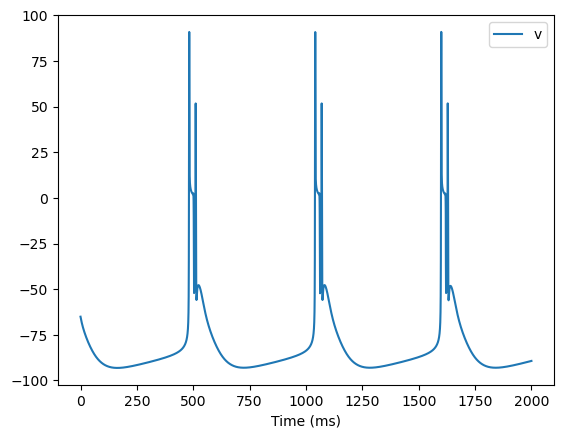Building Conductance-based Neuron Models#
@Xiaoyu Chen @chaoming0625
In this section, we try to understand how to build conductance-based biophysical neuron models.
import numpy as np
import brainpy as bp
import brainpy.math as bm
There are basically two types of neuron models: conductance-based models and simplified models. In conductance-based models, a single neuron can be regarded as a electric circuit, where the membrane is a capacitor, ion channels are conductors, and ion gradients are batteries. The neuronal activity is captured by the current flows through those ion channels. Sometimes there is an external input to this neuron, which can also be included in the equivalent circuit (see the figure below which shows potassium channels, sodium channels and leaky channels).
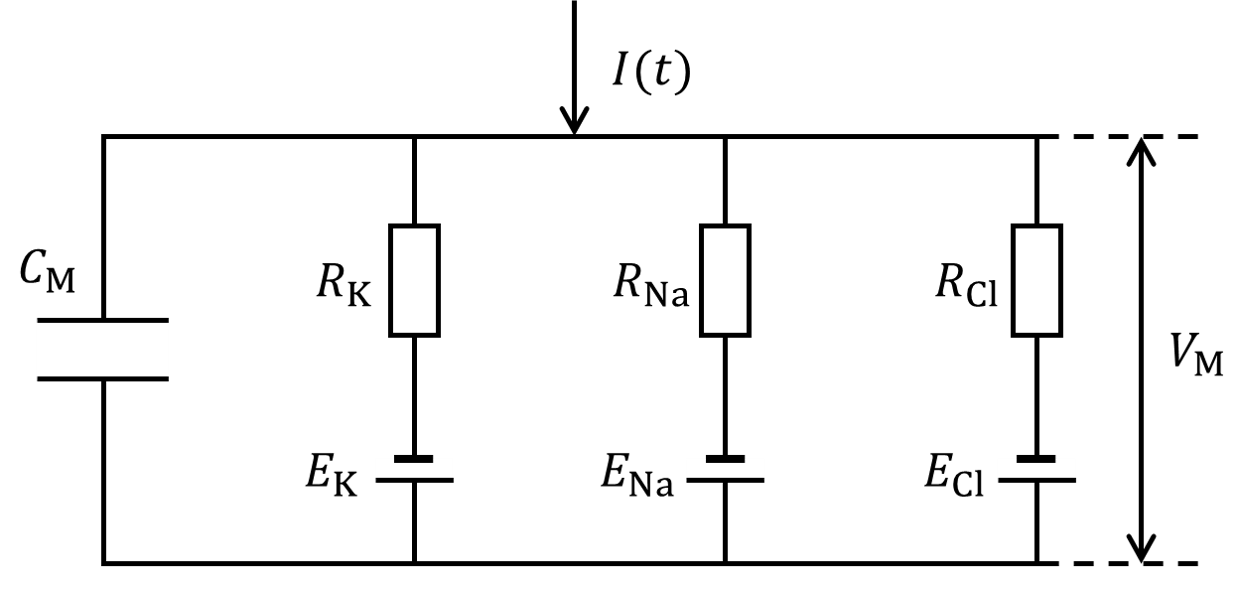
On the other hand, simplified models do not care about the physiological features of neurons but mainly focus on how to reproduce the exact spike timing. Therefore, they are more simplified and maybe not biologically explicable.
BrainPy provides a large volume of predefined neuron models including conductance-based and simplified models for ease of use. In this section, we will only talk about how to build conductance-based models by ion channels. Users please refer to Customizing Your Neuron Models for more information.
master_type organizes structures between neurons and ion channels#
When defining a conductance neuron model, one additional thing need to be pay attention to is master_type.
master_type determines what information will be passed into .reset_state() and update() function in a model.
class IK(bp.dyn.IonChannel):
master_type = bp.dyn.CondNeuGroup
def update(self, V, *args, **kwargs):
pass
def reset_state(self, V, *args, **kwargs):
pass
For the above IK model, its master_type: bp.dyn.CondNeuGroup will give V variable into this node. Therefore, IK model can utilize V to update or reset its states.
class ICa(bp.dyn.IonChannel):
master_type = bp.dyn.Calcium
def update(self, V, C, E, *args, **kwargs):
pass
def reset_state(self, V, C, E, *args, **kwargs):
pass
For ICa class, its master_type (bp.dyn.Calcium) will deliver the concentration of Calcium C and the reversal potential of Calcium ion E into this node. Moreover, since the master_type of bp.dyn.Calcium is bp.dyn.CondNeuGroup, it will inherit the passing of bp.dyn.CondNeuGroup and deliver V into ICa class too.
class ICaNa(bp.dyn.IonChannel):
master_type = bp.mixin.JointType[bp.dyn.Calcium, bp.dyn.Sodium]
def update(self, V, Ca_info, Na_info, *args, **kwargs):
pass
def reset_state(self, V, Ca_info, Na_info, *args, **kwargs):
pass
If an ion channel depends on more than two ion types, it can define master_type as a joint type by using brainpy.mixin.JointType. For example, the above ICaNa class depends on bp.dyn.Calcium and bp.dyn.Sodium, so the update() and reset_state() function depends on information of both subclasses and their parents.
For an existing ion channel, users can check the master_type using:
bp.dyn.INa_Ba2002v2.master_type
brainpy._src.dyn.ions.sodium.Sodium
bp.dyn.INa_Ba2002.master_type
brainpy._src.dyn.neurons.hh.HHTypedNeuron
Build a HH model by composing existing ion channels#
Instead of building a conductance-based model from scratch, we can utilize ion channel models as building blocks to assemble a neuron model in a modular and convenient way. Now let’s try to construct a Hodgkin-Huxley (HH) model (jump to here for the complete mathematical expression of the HH model).
The HH neuron models the current flows of potassium, sodium, and leaky channels. We can import the other channel models from brainpy.dyn.ions and brainpy.dyn.channels modules. Then we wrap these three channels into a single neuron model:
Here is an example by building a HH neuron model by composing existing ion channels.
class HH(bp.dyn.CondNeuGroupLTC):
def __init__(self, size):
super().__init__(size)
self.INa = bp.dyn.INa_HH1952(size)
self.IK = bp.dyn.IK_HH1952(size)
self.IL = bp.dyn.IL(size, E=-54.387, g_max=0.03)
Here the HH class should inherit the superclass brainpy.dyn.CondNeuGroup, which will automatically integrate the current flows by calling the current() function of each channel model to compute the neuronal activity when running a simulation.
Surprisingly, the model construction is finished! Users do not need to implement the update function of the neuron model as brainpy.dyn.CondNeuGroupLTC has its own way to update variables (like the membrane potential V and spiking sequence spike) implicitly.
Now let’s run a simulation of this HH model to examine the changes of the inner variables.
hh = HH(1)
runner = bp.DSRunner(hh, monitors={'na-p': hh.INa.p, 'na-q': hh.INa.q, 'k-p': hh.IK.p, 'v': hh.V})
inputs = np.ones(1000) * 4.
_ = runner.run(inputs=inputs)
bp.visualize.line_plot(runner.mon.ts, runner.mon['na-p'], legend='Na-p')
bp.visualize.line_plot(runner.mon.ts, runner.mon['na-q'], legend='Na-q')
bp.visualize.line_plot(runner.mon.ts, runner.mon['k-p'], legend='K-p', show=True)
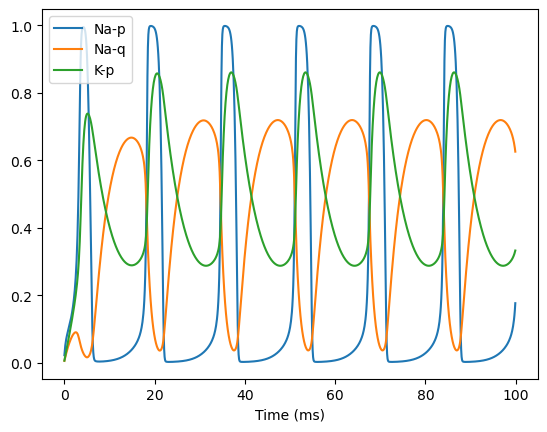
bp.visualize.line_plot(runner.mon.ts, runner.mon['v'], show=True)

Customizing ion channels#
To customize an ion channel that can be composed using the above interface, users should define a normal DynamicalSystem with the specification of master_type. Below we will show several examples.
As we have known, ion channels are crucial for conductance-based neuron models. So how do we model an ion channel? Let’s take a look at the potassium channel for instance.

The diagram above shows how a potassium channel is changed to an electric circuit. By this, we have the differential equation:
in which \(c_\mathrm{M}\) is the membrane capacitance, \(\mathrm{d}V_\mathrm{M}\) is the membrane potential, \(E_\mathrm{K}\) is the equilibrium potential of potassium ions, and \(R_\mathrm{K}\) (\(g_\mathrm{K}\)) refers to the resistance (conductance) of the potassium channel. We define currents from inside to outside as the positive direction.
In the equation above, the conductance of potassium channels \(g_\mathrm{K}\) does not remain a constant, but changes according to the membrane potential, by which the channel is categorized as voltage-gated ion channels. If we want to build an ion channel model, we should figure out how the conductance of the ion channel changes with membrane potential.
Fortunately, there has been a lot of work addressing this issue to formulate analytical expressions. For example, the conductance of one typical potassium channel can be written as:
in which \(\bar{g}_\mathrm{K}\) refers to the maximal conductance and \(n\), also named the gating variable, refers to the probability (proportion) of potassium channels to open. \(\phi\) is a parameter showing the effects of temperature. In the differential equation of \(n\), there are two parameters, \(\alpha_n(V)\) and \(\beta_n(V)\), that change with membrane potential:
Now we have learned the mathematical expression of the potassium channel. Next, we try to build this channel in BrainPy.
class IK(bp.dyn.IonChannel):
master_type = bp.dyn.HHTypedNeuron
def __init__(self, size, E=-77., g_max=36., phi=1., method='exp_auto'):
super().__init__(size)
self.g_max = g_max
self.E = E
self.phi = phi
self.integral = bp.odeint(self.dn, method=method)
def dn(self, n, t, V):
alpha_n = 0.01 * (V + 55) / (1 - bm.exp(-(V + 55) / 10))
beta_n = 0.125 * bm.exp(-(V + 65) / 80)
return self.phi * (alpha_n * (1. - n) - beta_n * n)
def reset_state(self, V, batch_or_mode=None, **kwargs):
self.n = bp.init.variable_(bm.zeros, self.num, batch_or_mode)
def update(self, V):
t = bp.share.load('t')
dt = bp.share.load('dt')
self.n.value = self.integral(self.n, t, V, dt=dt)
def current(self, V):
return self.g_max * self.n ** 4 * (self.E - V)
Note that besides the initialzation and update function, another function named current() that computes the current flow through this channel must be implemented. Then this potassium channel model can be used as a building block for assembling a conductance-based neuron model.
For a sodium ion channel,
where \(V_{sh}\) is the membrane shift (default -45 mV), and \(\phi\) is the temperature-dependent factor (default 1.).
class INa(bp.dyn.IonChannel):
master_type = bp.dyn.HHTypedNeuron
def __init__(self, size, E=50., g_max=120., phi=1., method='exp_auto'):
super(INa, self).__init__(size)
self.g_max = g_max
self.E = E
self.phi = phi
self.integral = bp.odeint(bp.JointEq(self.dm, self.dh), method=method)
def dm(self, m, t, V):
alpha_m = 0.11 * (V + 40) / (1 - bm.exp(-(V + 40) / 10))
beta_m = 4 * bm.exp(-(V + 65) / 18)
return self.phi * (alpha_m * (1. - m) - beta_m * m)
def dh(self, h, t, V):
alpha_h = 0.07 * bm.exp(-(V + 65) / 20)
beta_h = 1. / (1 + bm.exp(-(V + 35) / 10))
return self.phi * (alpha_h * (1. - h) - beta_h * h)
def reset_state(self, V, batch_or_mode=None, **kwargs):
self.m = bp.init.variable_(bm.zeros, self.num, batch_or_mode)
self.h = bp.init.variable_(bm.zeros, self.num, batch_or_mode)
def update(self, V):
t = bp.share.load('t')
dt = bp.share.load('dt')
self.m.value, self.h.value = self.integral(self.m, self.h, t, V, dt=dt)
def current(self, V):
return self.g_max * self.m ** 3 * self.h * (self.E - V)
The leakage channel current.
class IL(bp.dyn.IonChannel):
master_type = bp.dyn.HHTypedNeuron
def __init__(self, size, E=-54.39, g_max=0.03):
super(IL, self).__init__(size)
self.g_max = g_max
self.E = E
def reset_state(self, *args, **kwargs):
pass
def update(self, V):
pass
def current(self, V):
return self.g_max * (self.E - V)
We can compose a HH model by using three channels we defined in the above.
class HH(bp.dyn.CondNeuGroup):
def __init__(self, size):
super().__init__(size, V_initializer=bp.init.Uniform(-80, -60.))
self.IK = IK(size, E=-77., g_max=36.)
self.INa = INa(size, E=50., g_max=120.)
self.IL = IL(size, E=-54.39, g_max=0.03)
neu = HH(1)
neu.reset()
inputs = np.ones(int(200 / bm.dt)) * 1.698 # 200 ms
runner = bp.DSRunner(neu, monitors=['V', 'IK.n', 'INa.m', 'INa.h'])
runner.run(inputs=inputs) # the running time is 200 ms
import matplotlib.pyplot as plt
plt.plot(runner.mon['ts'], runner.mon['V'])
plt.xlabel('t (ms)')
plt.ylabel('V (mV)')
plt.show()
plt.figure(figsize=(6, 2))
plt.plot(runner.mon['ts'], runner.mon['IK.n'], label='n')
plt.plot(runner.mon['ts'], runner.mon['INa.m'], label='m')
plt.plot(runner.mon['ts'], runner.mon['INa.h'], label='h')
plt.xlabel('t (ms)')
plt.legend()
plt.show()
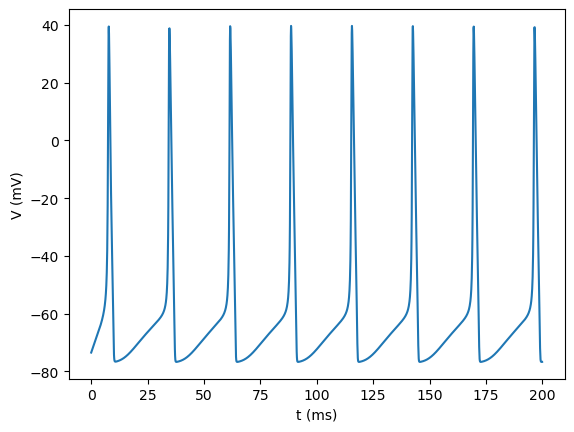
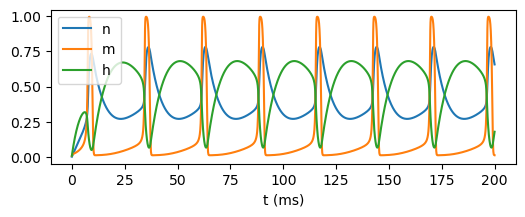
Building a complex thalamus neuron model#
Li, et. al [1] proposed a point model of thalamic cells, all single cell models in the thalamic network contained one single compartment and multiple ionic currents described by the Hodgkin-Huxley formulism. The current balance equation was given by:
where \(Cm = 1μF/cm^2\) is the membrane capacitance for all four types of neurons, \(g_L\) is the leakage conductance (nominal value: \(gL = 0.01 mS/cm^2\) for all four types of cells) and \(g_{KL}\) is the potassium leak conductance modulated by both ACh and NE. \(E_L\) is the leakage reversal potential (\(E_L\) = −70 mV for both HTC cells), and \(E_{KL}\) is the reversal potential for the potassium leak current (\(E_{KL}\) = −90 mV for all neurons). \(I_{int}\) and \(I_{syn}\) are the intrinsic ionic currents (in \(μA/cm^2\)) and synaptic currents (in \(nA\)) respectively and \(I_{app}\) is the externally applied current injection (in \(nA\)). The following total membrane area (A) was used to normalize the synaptic and externally applied currents in Eq: HTC cells: 2.9×10−4 \(cm^2\).
HTC cells contained the following six active ionic currents:
a spike generating fast sodium current (INa),
bp.dyn.INa_Ba2002a delayed rectifier potassium current (IDR),
bp.dyn.IKDR_Ba2002a hyperpolarization-activated cation current (IH),
bp.dyn.Ih_HM1992a high-threshold L-type Ca2+ current (ICa/L),
bp.dyn.ICaL_IS2008a Ca2+- dependent potassium current (IAHP),
bp.dyn.IAHP_De1994a Ca2+- activated nonselective cation current (ICAN).
bp.dyn.ICaN_IS2008
In addition, both TC cells included
a regular low-threshold T-type Ca2+ current (ICa/T),
bp.dyn.ICaT_HM1992and a high-threshold T-type Ca2+ current (ICa/HT);
bp.dyn.ICaHT_HM1992
To obtain the high-threshold T-type current ICa/HT, both the activation and inactivation of the ICa/T current was shifted by 28 mV, similar to a previous TC modeling study.
[1] Li G, Henriquez CS, Fröhlich F (2017) Unified thalamic model generates multiple distinct oscillations with state-dependent entrainment by stimulation. PLoS Comput Biol 13(10): e1005797. https://doi.org/10.1371/journal.pcbi.1005797
In BrainPy, this model can be modeled as:
class HTC(bp.dyn.CondNeuGroupLTC):
def __init__(self, size, gKL=0.01, V_initializer=bp.init.OneInit(-65.)):
super().__init__(size, A=2.9e-4, V_initializer=V_initializer, V_th=20.)
self.IL = bp.dyn.IL(size, g_max=0.01, E=-70.)
self.INa = bp.dyn.INa_Ba2002(size, V_sh=-30)
self.Ih = bp.dyn.Ih_HM1992(size, g_max=0.01, E=-43)
self.Ca = bp.dyn.CalciumDetailed(size, C_rest=5e-5, tau=10., d=0.5)
self.Ca.add_elem(bp.dyn.ICaL_IS2008(size, g_max=0.5))
self.Ca.add_elem(bp.dyn.ICaN_IS2008(size, g_max=0.5))
self.Ca.add_elem(bp.dyn.ICaT_HM1992(size, g_max=2.1))
self.Ca.add_elem(bp.dyn.ICaHT_HM1992(size, g_max=3.0))
self.K = bp.dyn.PotassiumFixed(size, E=-90.)
self.K.add_elem(bp.dyn.IKDR_Ba2002v2(size, V_sh=-30., phi=0.25))
self.K.add_elem(bp.dyn.IK_Leak(size, g_max=gKL))
self.KCa = bp.dyn.MixIons(self.K, self.Ca)
self.KCa.add_elem(bp.dyn.IAHP_De1994v2(size))
htc = HTC(1)
runner = bp.DSRunner(htc, monitors={'v': htc.V})
I = -30 / 1e3 / 2.9e-4 * 1e-3 # input current = -30pA
inputs = np.ones(20000) * I
runner.run(inputs=inputs)
bp.visualize.line_plot(runner.mon.ts, runner.mon['v'], legend='v', show=True)
